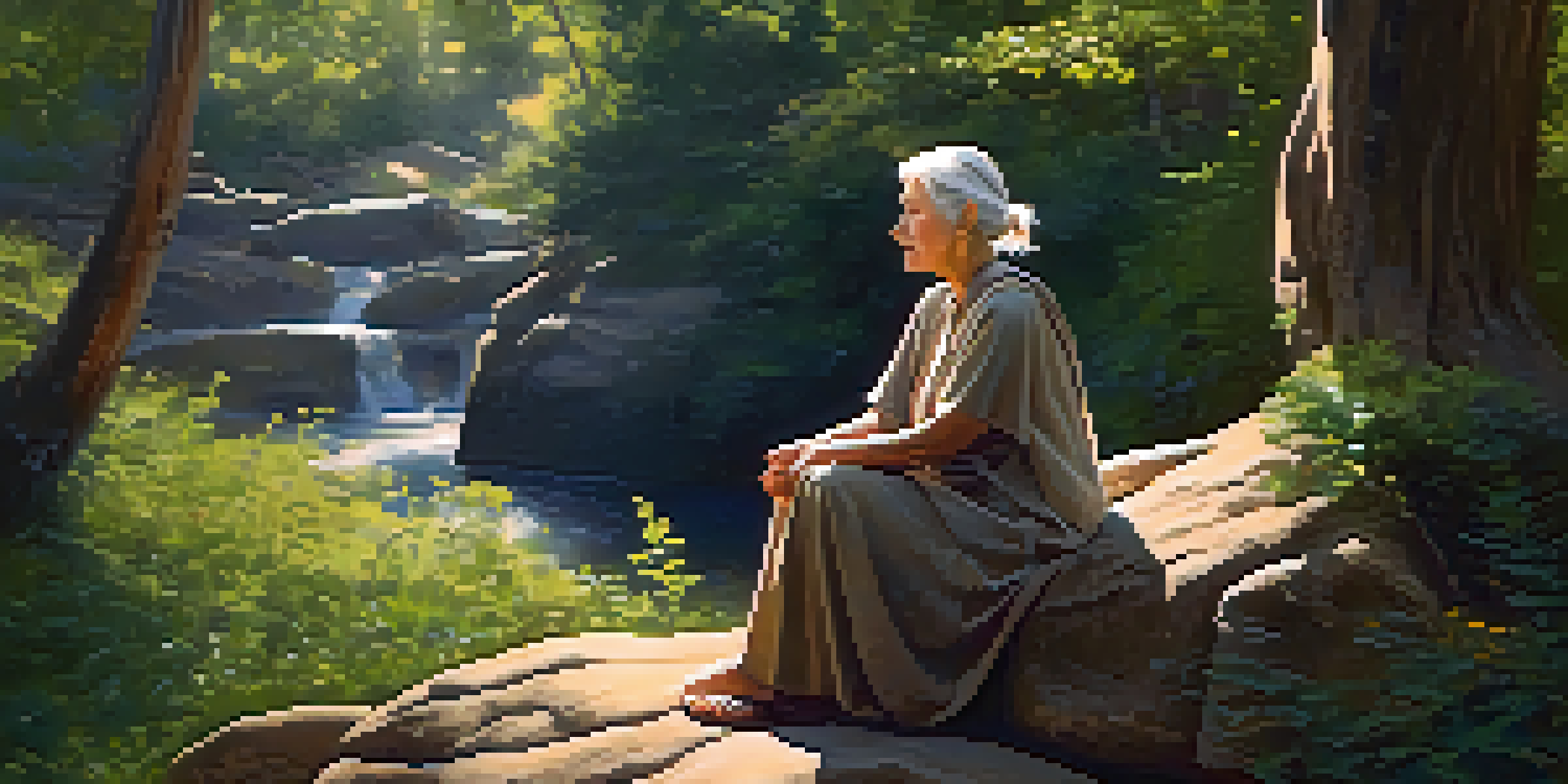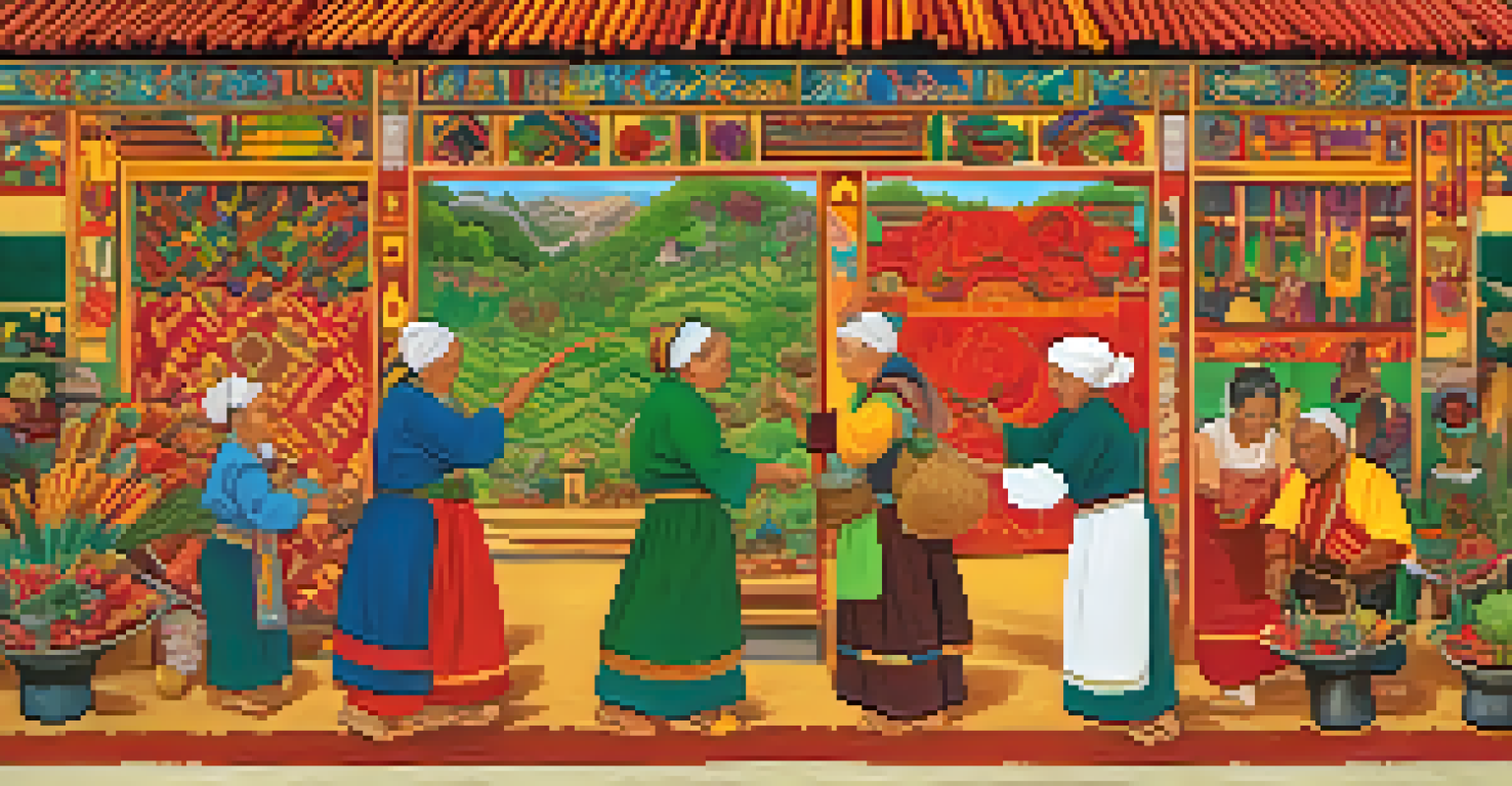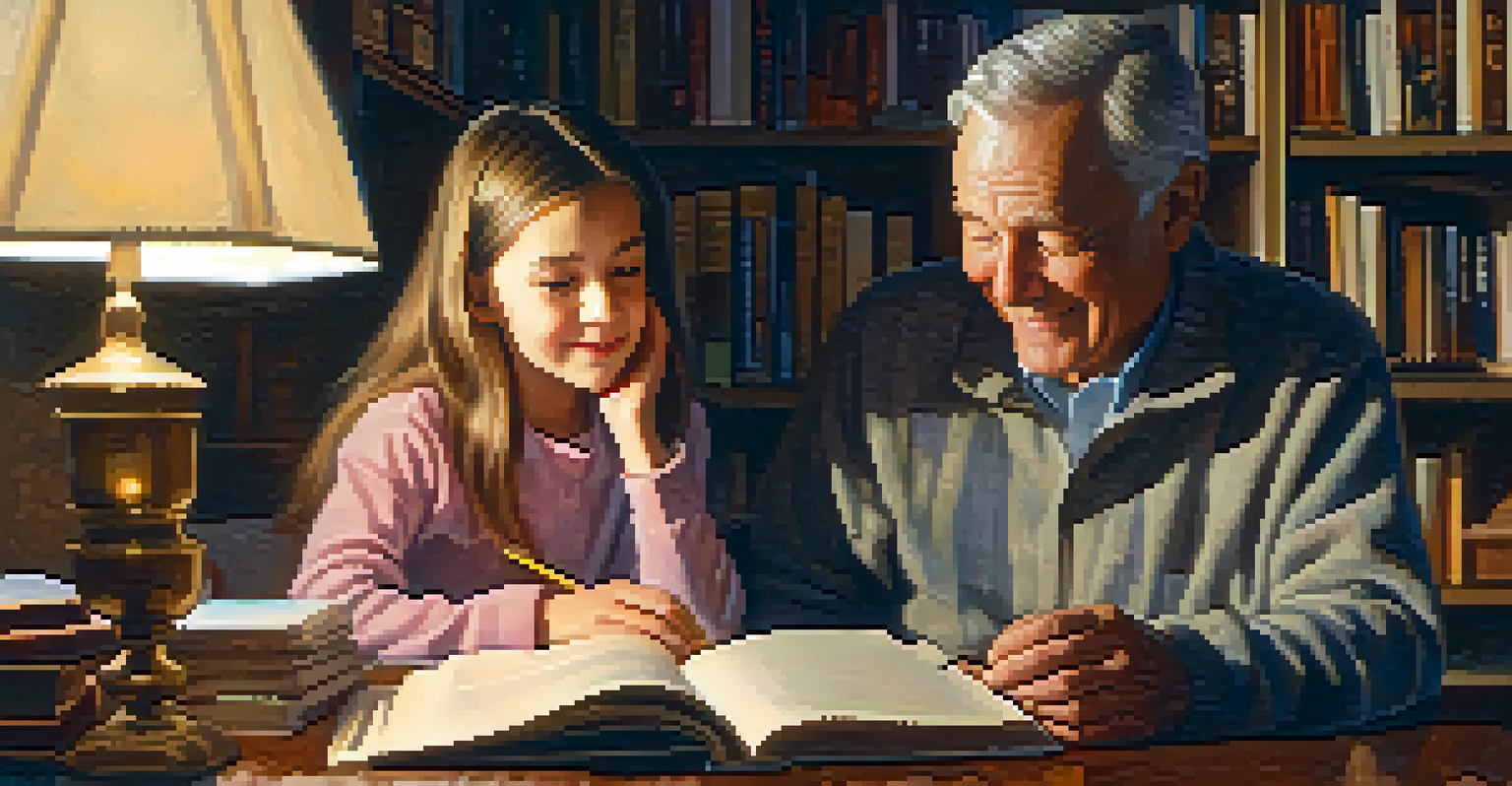Exploring Folklore and Aging in Cultural Artworks

The Role of Folklore in Cultural Narratives
Folklore serves as the backbone of many cultures, weaving together stories that reflect the values and beliefs of a community. These narratives often include lessons about aging, imparting wisdom and experiences that resonate across generations. For instance, tales of elder figures in folklore highlight their roles as keepers of knowledge, demonstrating the respect afforded to age within various societies.
Aging is not lost youth but a new stage of opportunity and strength.
In many cultures, elders are revered as sources of wisdom, with folklore encapsulating their life experiences and teachings. This respect is often depicted through myths and legends where the elderly character guides younger ones, emphasizing the importance of listening to those who have walked the path before. Such stories not only preserve cultural values but also illustrate the significance of aging as a natural and respected part of life.
Furthermore, exploring these narratives allows us to appreciate the diversity of perspectives on aging. From the wise old woman in European fairy tales to the revered ancestors in Indigenous stories, these characters provide a rich tapestry of cultural attitudes toward growing older. This diversity highlights how folklore can shape our understanding of aging in meaningful and impactful ways.
Artistic Representations of Aging in Folklore
Artists have long drawn inspiration from folklore, especially in how they portray aging. Visual artworks like paintings and sculptures often depict elders in ways that celebrate their wisdom and experience. For example, in many traditional paintings, older figures are shown surrounded by nature, symbolizing their deep connection to life and the cycles of existence.

These artistic representations serve not only to honor aging but also to challenge societal perceptions. By portraying elders with dignity and depth, artists invite viewers to reconsider their biases about aging. This is particularly important in modern contexts, where ageism can lead to undervaluing elders' contributions and stories.
Folklore Shapes Aging Perspectives
Folklore influences cultural views on aging, often portraying it as a respected journey filled with wisdom and growth.
Moreover, folklore-inspired artworks can evoke nostalgia, prompting audiences to reflect on their own relationships with aging family members. Through themes of memory and legacy, these artworks bridge generational gaps, reminding us of the importance of storytelling in preserving experiences and values across time. In doing so, they enrich our cultural understanding of what it means to grow older.
Folklore and Its Impact on Aging Perceptions
Folklore significantly influences how different cultures perceive aging and the elderly. In many traditions, aging is viewed as a journey filled with growth, rather than a decline. This perspective is often encapsulated in stories that celebrate life's later stages, showcasing the vibrancy and vitality that can accompany aging.
The greatest gift of life is friendship, and I have received it.
These narratives can reshape societal attitudes, encouraging a more positive view of aging. For example, in some Asian cultures, elders are often depicted as wise and capable, reinforcing the belief that age brings value. Such representations can counteract negative stereotypes that dominate modern media, fostering greater appreciation for the elder population.
Additionally, folklore can serve as a tool for intergenerational dialogue, bridging the gap between young and old. By sharing these stories, younger generations can learn to appreciate the insights and experiences of their elders. This exchange not only enriches cultural understanding but also strengthens community bonds, creating a more inclusive narrative around aging.
The Intersection of Folklore and Modern Aging Issues
As society evolves, so too does the dialogue around aging, particularly in the context of folklore. Modern issues such as mental health, technology, and societal expectations have shifted how we view and represent aging in cultural narratives. For instance, contemporary folklore may tackle themes of loneliness and disconnection, reflecting the realities many elders face today.
Artists and storytellers are increasingly incorporating these themes into their works, providing a platform for discussing the challenges of aging in the modern world. By addressing topics like isolation and the digital divide, they create a more nuanced understanding of what it means to grow older today. This evolution of folklore ensures that it remains relevant and reflective of current societal issues.
Art Reflects Aging with Dignity
Art inspired by folklore celebrates the elderly, challenging ageism and inviting audiences to appreciate their contributions.
Moreover, this intersection encourages a dialogue about solutions and community support for the elderly. By weaving modern concerns into traditional narratives, we can inspire action and awareness, fostering a culture that values and uplifts its aging population. In this way, folklore continues to play a vital role in shaping our understanding and approach to aging.
Lessons from Folklore: Embracing the Aging Process
One of the most profound lessons that folklore teaches us about aging is the importance of acceptance and resilience. Many stories illustrate characters who embrace their age, finding joy and purpose in their later years. These narratives encourage individuals to view aging not as a burden but as an opportunity for growth and self-discovery.
For instance, the tale of the tortoise and the hare reminds us that wisdom and patience often triumph over youth and speed. This allegory serves as a reminder that the aging process comes with its unique strengths, encouraging us to embrace our own journey with grace. Such stories can inspire both young and old to respect the aging process and value the experiences that come with it.
Furthermore, embracing these lessons can lead to a healthier relationship with aging in our own lives. By recognizing the beauty and wisdom that come with age, we can foster a society that honors and celebrates its elders. This perspective shifts the narrative from one of fear and denial to one of appreciation and empowerment, enriching our collective understanding of what it means to grow older.
Folklore as a Medium for Aging Conversations
Folklore can serve as an effective medium for initiating conversations about aging in our communities. Storytelling creates a safe space for sharing experiences and emotions related to growing older. By using folklore as a conversational tool, we can break down barriers and foster understanding among different generations.
In community workshops or storytelling events, participants can explore their own relationships with aging through traditional tales. This engagement not only promotes intergenerational dialogue but also encourages participants to reflect on their values and beliefs regarding aging. Such discussions help demystify the aging process, making it a topic of interest rather than one to shy away from.
Modern Issues in Aging Narratives
Contemporary folklore addresses current challenges faced by the elderly, ensuring narratives remain relevant and reflective of societal issues.
Moreover, these conversations can lead to greater awareness of the needs and challenges faced by the elderly. By highlighting their stories and struggles through folklore, we can advocate for better support systems and resources. Ultimately, using folklore as a medium for these discussions empowers communities to create a more inclusive environment for all ages.
The Future of Folklore and Aging in Cultural Contexts
As we move forward, the relationship between folklore and aging will continue to evolve. With changes in demographics and societal attitudes, new stories will emerge to reflect contemporary experiences of aging. This adaptability ensures that folklore remains a relevant and powerful tool for exploring the complexities of growing older.
The incorporation of diverse voices in folklore will enrich our understanding of aging, offering multiple perspectives that reflect the realities of various communities. As artists and storytellers embrace inclusivity, we can expect to see narratives that challenge traditional stereotypes and celebrate the richness of aging across cultures. This shift can lead to a more profound appreciation for the elder population and their contributions.

Ultimately, the future of folklore and aging hinges on our willingness to engage with these narratives thoughtfully. By listening, sharing, and creating, we can cultivate a culture that honors the wisdom of its elders and embraces the aging process as a vital part of the human experience. Through this ongoing dialogue, folklore will continue to illuminate the beauty and challenges of aging for generations to come.